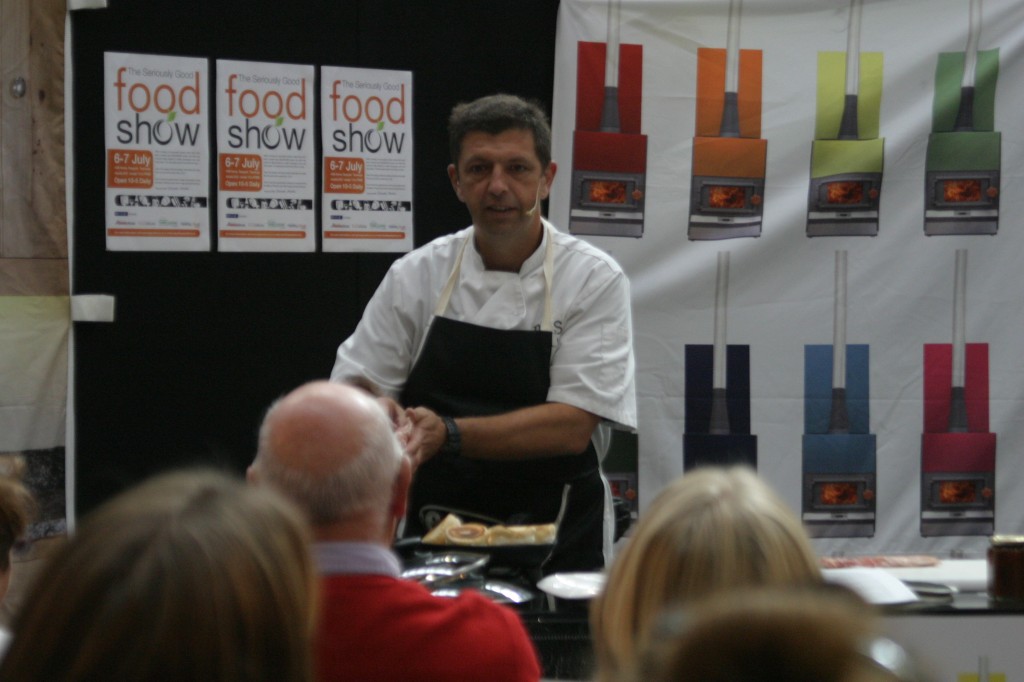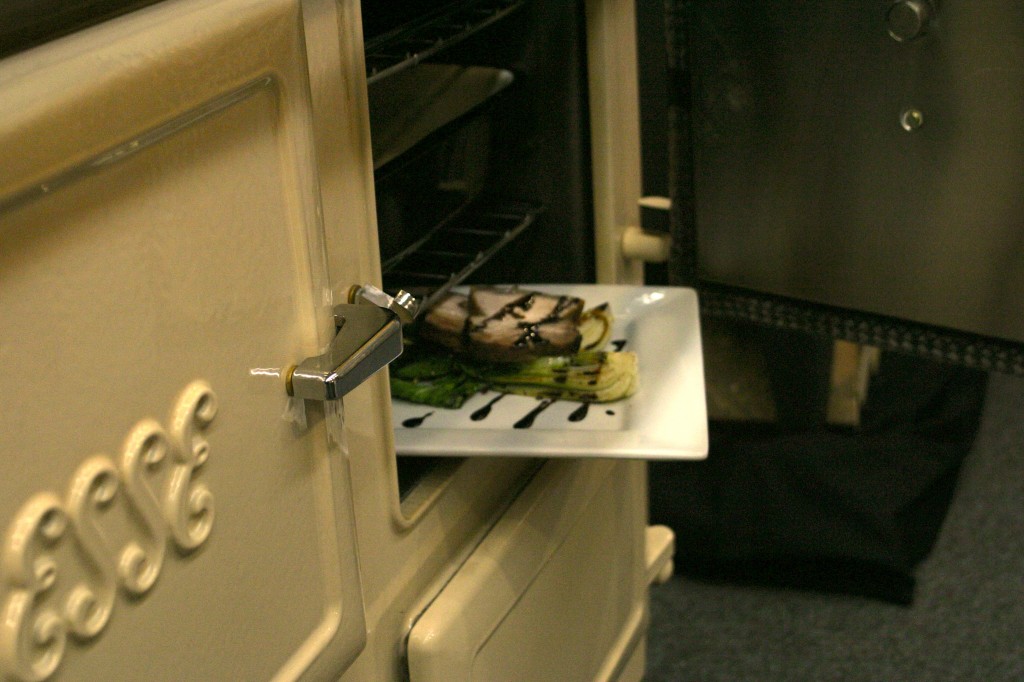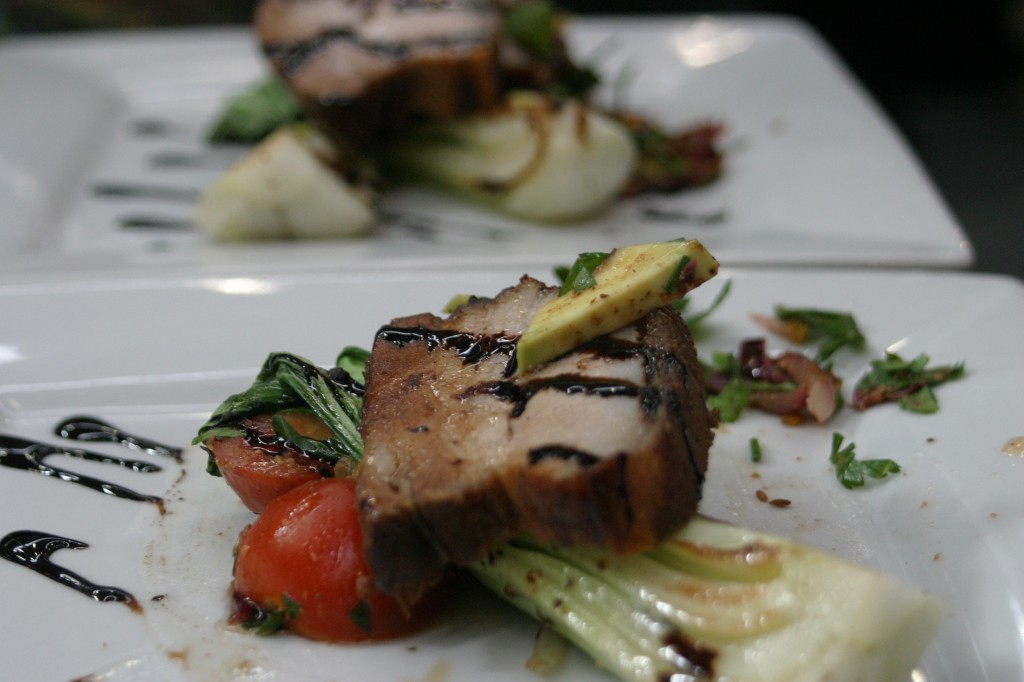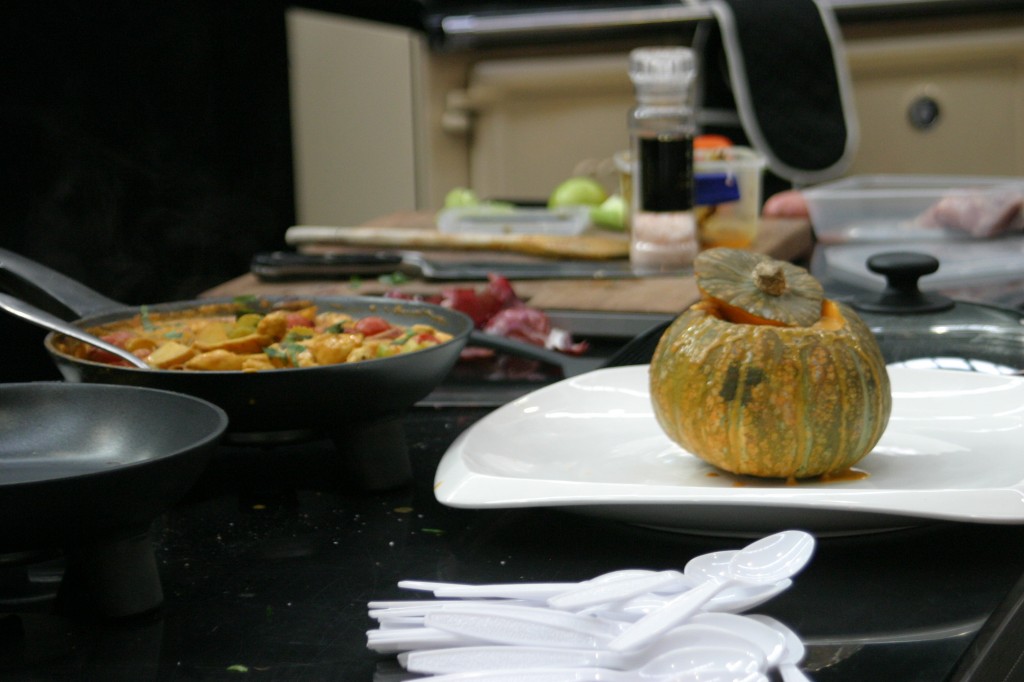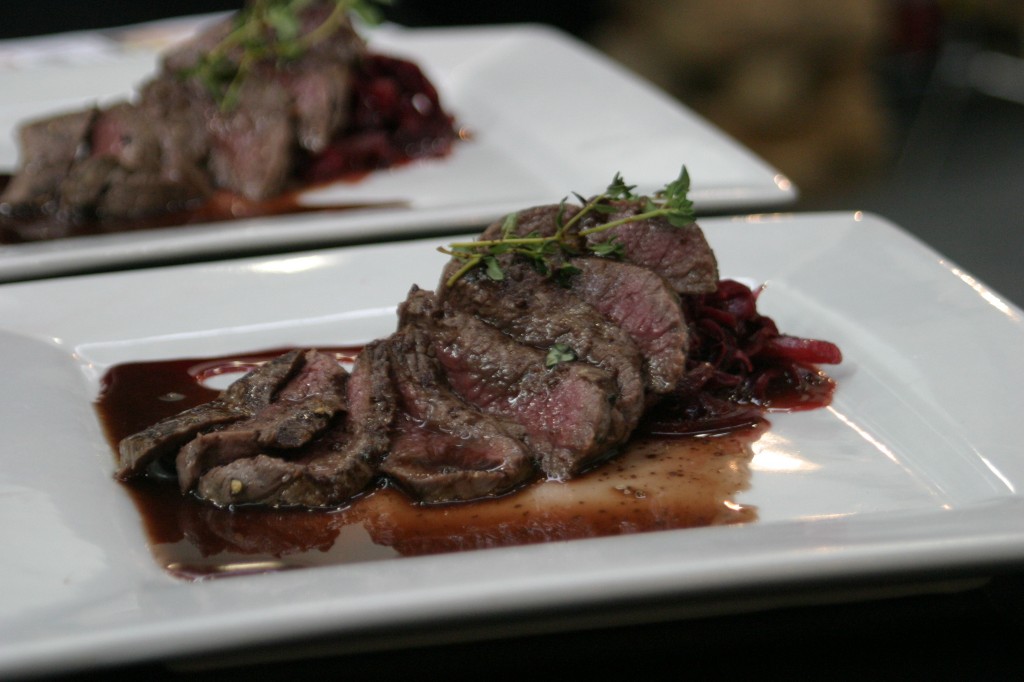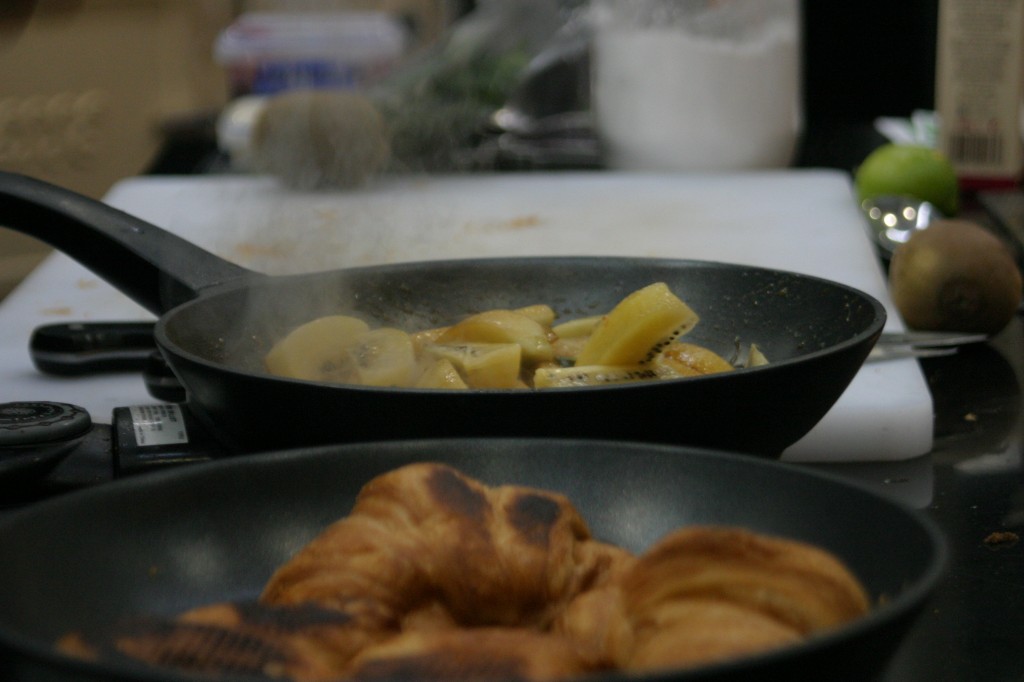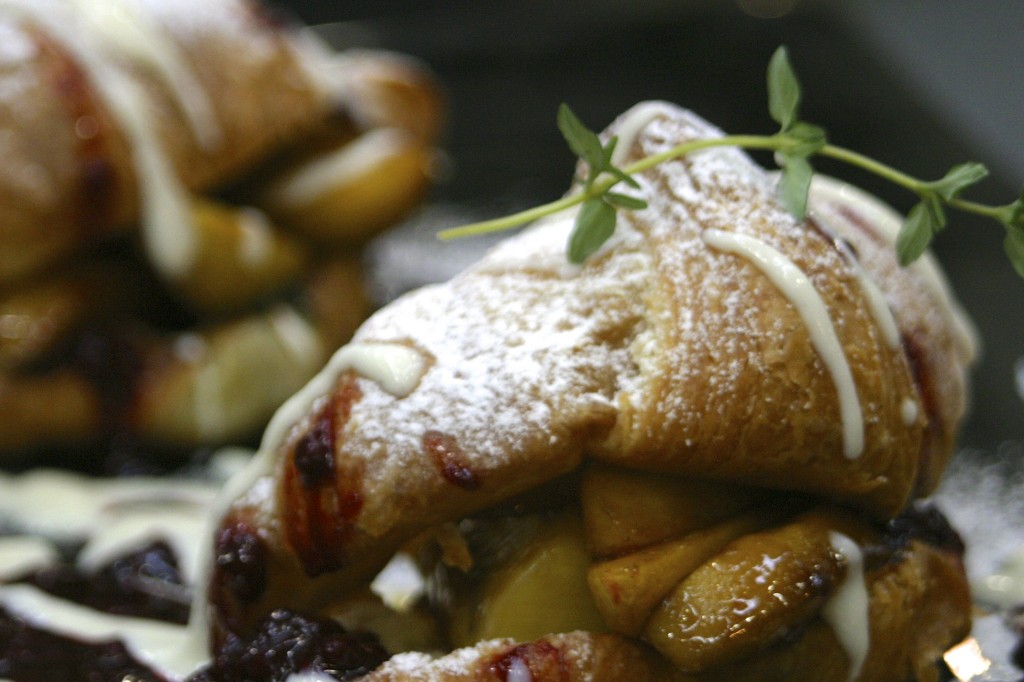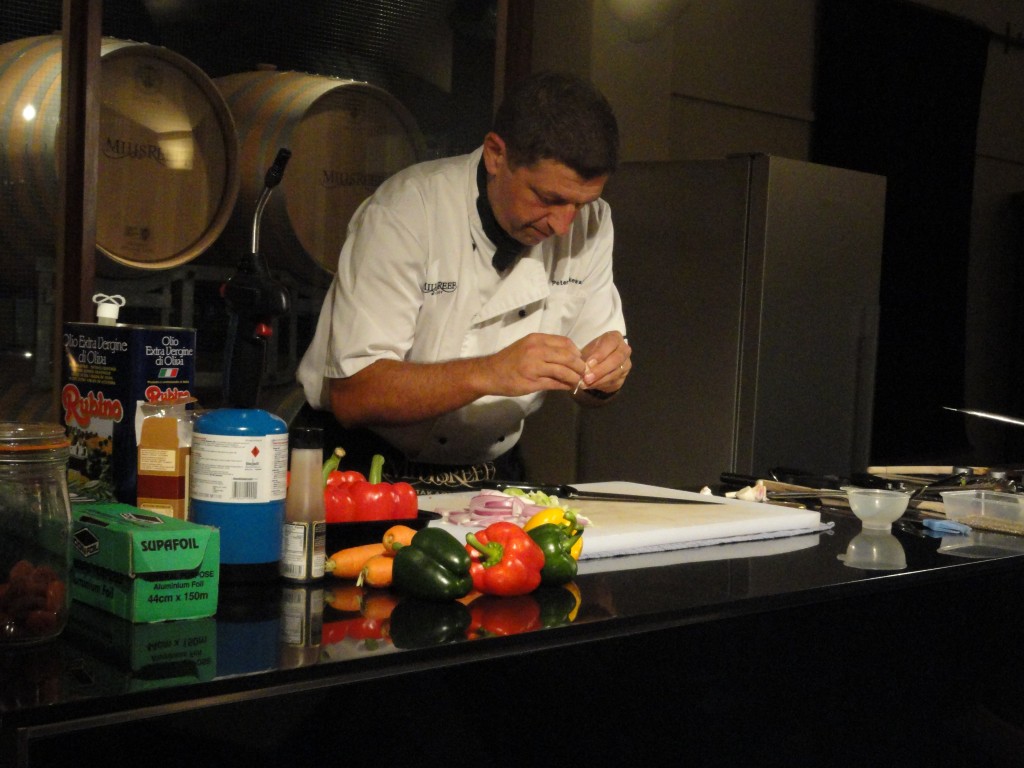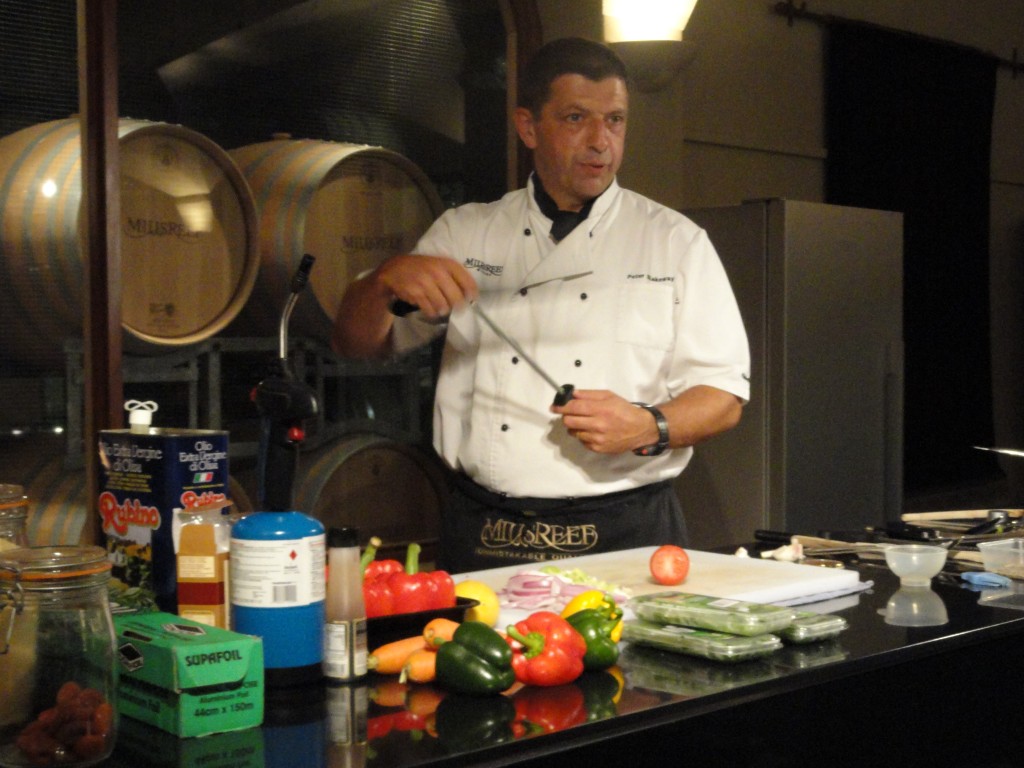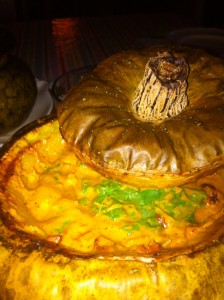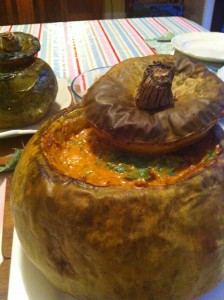It has been a great first day at the home show here are the recipes
Chinese Crisp Roasted Pork
1 x 1kg piece fresh belly pork, boned but not skinned
2 cloves garlic, finely chopped
1 tablespoon light soy sauce
3 teaspoons salt
½ teaspoon five-spice powder
Method
Score pork skin at 1cm intervals, using a very sharp knife and cutting right through the skin. Blanch meat in a large sauce pan of boiling water for 2 minutes, then lift out, rinse under cold water and dry well with kitchen paper. Combine garlic and soy sauce and rub all over meat side of pork. Combine salt and five-spice powder and rub all over skin. Refrigerate uncovered, skin-side up, for at least 2 hours or overnight.
Preheat oven to 230°C and line a baking dish with foil. Position a rack in baking dish and settle pork on rack, skin-side up. Bake for 20 minutes, then reduce oven temperature to 200°C and bake for 40 minutes or until skin crackles and crisps.
Cool a little before cutting into slices and then into thick fingers. Serve hot with steamed rice and Asian greens or at room temperature as an entrée with a dish of hoi sin sauce for dipping, or use in a stir-fry.
Gravadlax
There are as many recipes for this as there are spellings for it throughout Scandinavia – this one happens to be from a Danish friend. It is a fantastic alternative to smoked salmon with a fresh and subtle flavour.
Serves 10
1 whole side fresh salmon
2 heaped tablespoons sea salt
2 rounded tablespoons granulated sugar
2 teaspoons crushed black pepper
2 tablespoons spirit alcohol ( I use vodka, but be creative)
2 rounded tablespoons fresh dill
- Mix together salt, sugar, pepper, alcohol and dill.
- Spread the mixture over the salmon.
- wrap with gladwrap and then tin foil.
- Weigh down with a couple of tins and refrigerate, turning daily, for up to 5 days. You’ll notice a liquid seep out of the fish, don’t worry that is just the water coming out and can be discarded each day.
- Serve as a canapé, starter or for the truly enlightened with scrambled eggs on Mothering Sunday.
Truffled Poached Chicken
The unbelievable aromas when this dish is cooking are to die for! If you’re selling your house, forget fresh roasted coffee and baking bread – the smell when this is cooking will have them queuing out of the door! Truffles can be very expensive but will transform an everyday dish into something truly extraordinary. You only live once after all!
1.35kg free range chicken
2 medium carrots, peeled
2 sticks celery, sliced
1 onion, skin on but topped and tailed
4 medium leeks, washed and cut into 2.5cm slices
115g unsalted butter
bouquet garni of parsley stalks, 8 black peppercorns and a sprig of thyme, tied in muslin
2.25 litres chicken stock or water
1 black truffle (about 50g)
salt and pepper
- Gently scrub the truffle, peel it (reserving the trimmings) and slice very thinly.
- Slip the truffle slices under the skin of the chicken evenly on both sides, ensuring some slices are also under the leg skin.
- Place the chicken into a large pan with all the vegetables (except the leeks), bouquet garni and chicken stock and bring to the boil.
- Turn down heat, season with salt and pepper and simmer uncovered for 60 minutes.
- Remove chicken, drain and keep in a warm place.
- Sieve the stock and return to a clean saucepan on a high heat.
- As it comes to the boil, skim the ‘scum’ that forms on the surface and continue to boil for 5 to 10 minutes.
- Meanwhile, blanch the leeks in a pan of rapidly boiling water for 3 minutes and drain.
- Chop the truffle peelings finely and mash together in a bowl with the softened butter, salt and pepper.
- Melt the truffled butter in a fry pan over a medium heat, add the leeks and cook gently until hot.
- Serve the broth first in soup plates, followed by the warm chicken and leeks.
Braised Beef Cheeks
2 beef cheeks
300ml hearty red wine
1/2-1 tsp Chinese five spice
2 tbsp butter or even better, duck fat
salt and pepper to taste
2 cloves garlic, sliced very thinly
1. In a very hot heavy pan (cast iron would be the best option), sear the cheeks on both sides for approximately 1-2 minutes per side. Remove from pan and set in a slow cooker.
2. Pour the wine over top, sprinkle the cheeks liberally with Chinese five spice, toss in the butter (or duck fat), season to taste with salt and sprinkle the garlic over top.
3. Set the slow cooker to “low” and allow to cook uninterrupted for 8 hours.
4. When finished, remove from slow cooker gently (as they will be delicate and fall apart easily at this stage, and serve with accompanying vegetables or mashed potatoes.
Dauphinoise Potatoes
Serves 5 – 6
1 kg waxy potatoes, peeled and thinly sliced
1 large clove garlic, crushed
250ml milk
250ml cream
25g parmesan
Seasoning
Method
Bring the liquids to the boil with the garlic and add the potatoes. Simmer until potatoes are tender and liquid has thickened with the potato starch, stirring very gently a couple of times. Turn the potatoes out onto a buttered ovenproof dish. Grate the parmesan on top and bake in a preheated oven at 150˚C for approximately 1 hour or until golden brown on top. Can be used straight away or refrigerated and re-heated.
Saffron and Earl Grey Poached Pears
Pears hold their shape really well, as long as you don’t allow the liquor to boil once the pears have been added.
Serves 4
4 pears
1 split vanilla pod
1/2 bottle White wine
120g sugar
Pinch of Saffron
Earl Grey Tea Bag
zest and juice of 1/2 orange
a bunch of fresh thyme
125g butter
- Add all except the butter and the pears to a small casserole pan, bring to
the boil turn down to a gentle simmer and add the pears. Simmer for about 1 hour or until tender.
- Remove the pears and reduce the liquid by half.
- Away from the heat, add the butter and agitate for a while.
- Put the pears back in and leave until ready to serve.
- Warm is the best temperature to serve this dish.
Eggs Benedict with Smoked Salmon
Serves 2
2 English muffins
4 pieces ‘Aoraki’ smoked salmon
4 poached eggs (see below)
4 tablespoons ‘Quick Blender Hollandaise’ sauce (see below)
Method
Split each muffin, toast and butter. Cover each half with smoked salmon. Top with a poached egg and a good dollop of hollandaise sauce.
Perfect Poached Eggs
Serves 1
2 very fresh, free-range eggs
Plenty of boiling water
Method
Fill a large pan with water and bring to just below boiling. Use a spoon to get the water moving in a gentle circle and break the eggs in. Keep swirling the water gently while cooking the eggs – it may take up to 10 minutes. Do not rush the process; otherwise the white will separate from the egg.
To check if the egg is cooked, lift gently with a slotted spoon and check that none of the white is still transparent; it should be fairly solid and plump around the yolk.
Quick Blender Hollandaise
Makes 600ml
175g butter
2 tablespoons wine vinegar
4 tablespoons lemon juice
6 large egg yolks
A large pinch of salt
6 rounded tablespoons fresh chives, snipped
Method
Melt butter slowly in a small saucepan. Place wine vinegar and lemon juice in another pan and bring to the boil. Meanwhile blend egg yolks in a food processor or liquidiser, then – with the motor still running – gradually add the hot lemon and vinegar. When the butter reaches the boil, trickle this in very slowly, with motor still running until it is all added and the sauce is thickened. Stir in snipped chives. Serve immediately with barbequed salmon or vegetables, e.g. asparagus. Will also keep for up to 2 days if covered with glad wrap and refrigerated.
English Muffins
Makes 8
400g Hi-Tec white flour
1 tsp salt
25g butter
225ml milk
2 tsp dried yeast
1 egg
Butter or oil for frying
Method
Sift flour and salt into large bowl and rub in butter. Warm milk gently in a saucepan to blood heat, then sprinkle dried yeast on top and leave for 10 – 15 minutes until frothy. Beat in the egg. Add yeast liquid to the flour to make a very soft dough. Beat by hand or with a wooden spoon for about 5 minutes, until smooth and shiny. Cover with a large, lightly oiled plastic bag and leave in a warm place for 1 – 2 hours, or until doubled in size.
Knead again lightly and roll out onto a well floured surface to a thickness of about 1 cm. Cut into rounds and place on a floured baking sheet. Cover with plastic bag and leave to rise for about 45 minutes or until light and puffy. Heat oil or butter on a hot plate or heavy bottom frypan. Cook muffins for about 4 minutes on each side until golden.
Chinese Crisp Roasted Pork WITH BOK CHOY, PICKLED TOMATOES AND AVOCADO
1 x 1kg piece fresh belly pork, boned but not skinned
2 cloves garlic, finely chopped
1 tablespoon light soy sauce
3 teaspoons salt
- ½ teaspoon five-spice powder
- 2 cups cherry tomatoes
- 3 Tbsp. avocado oil
- 2 shallots, minced
- 2 jalapeños, sliced thinly
- ½ tsp. cumin seed, toasted and ground
- 1 tsp. mustard seeds, toasted and ground to a paste
- 4 Tbsp. lime juice, freshly squeezed
- 3 Tbsp. cider vinegar
- 1 Tbsp. brown sugar
- ¼ cup chopped mint
- ¼ cup chopped parsley
- 1 tsp. plus a pinch r salt
- 3 ripe, Fresh Avocados
- 1 tsp. vegetable oil
- 3 cups cleaned and thinly chopped bok choy
Method
Score pork skin at 1cm intervals, using a very sharp knife and cutting right through the skin. Blanch meat in a large sauce pan of boiling water for 2 minutes, then lift out, rinse under cold water and dry well with kitchen paper. Combine garlic and soy sauce and rub all over meat side of pork. Combine salt and five-spice powder and rub all over skin. Refrigerate uncovered, skin-side up, for at least 2 hours or overnight.
Preheat oven to 230°C and line a baking dish with foil. Position a rack in baking dish and settle pork on rack, skin-side up. Bake for 20 minutes, then reduce oven temperature to 200°C and bake for 40 minutes or until skin crackles and crisps.
Place the tomatoes in a glass or ceramic bowl that can withstand a little heat. Season the tomatoes with the salt.
In a large fry pan bring olive oil to a simmer over medium high heat, just below smoke point. Add shallot and then jalapeños. Fry off until tender, about two minutes and then add the cumin and the mustard seeds. Toast for about a minute and remove from heat.
Let cool slightly and then carefully add half of the lime juice and vinegar and then pour this over seasoned tomatoes. Add mint, parsley and about ½. of the kosher salt. Let the tomatoes sit at room temperature for the flavors to mature. While the pan is still hot add the bok choy and let it wilt in the pan, adding a pinch of salt to season
Cool a little before cutting into slices and then into thick fingers. Serve hot or at room temperature as an entrée with a dish of hoi sin sauce for dipping, or use in a stir-fry.
Baked Pumpkin
Ingredients
Serves 8
1 pumpkin, washed and scrubbed (about 5kg)
olive oil
1kg chicken, trimmed and large diced (about 2cm)
3 cloves garlic, crushed
2 onions, chopped
2 small green peppers, sliced
1 large celery stalk, chopped
1 green chilli, finely chopped
300 ml coconut cream
300 ml puréed tomatoes
1 tablespoon korma paste
Bouquet garni
3 tomatoes, skinned deseeded and chopped
3 potatoes, peeled and diced
corriander
Method
Preheat oven to 180˚C
Choose a pumpkin with a decent stem on it as this will serve as a handle in the lid. Cut the top off the pumpkin to form a lid and scoop all the seeds and stringy bits out. Put the lid back on and bake for 1 – 1½ hours or until tender but still firm. Once cooked scoop a little more of the flesh out to give enough space for the casserole being careful not to damage the outer layer and skin.
Meanwhile heat a few tablespoons of olive oil in a large pan and brown the chicken on all sides. Remove and set aside. In the same pan, adding more oil if necessary, fry off the onions, garlic, celery, capsicum, potatoes and chilli until soft. Add the korma paste and fry to release flavours. Pour in the tomato and coconut and bring to a simmer. Return the meat to the pan, add the tomatoes, bouquet garni and seasoning to taste, cover and cook gently for 20 minutes.
Spoon the casserole into the pumpkin and bake in the oven for a further 20 minutes.
Carefully place the pumpkin on a serving dish and fish out the bouquet garmi before serving.
Venison Loin with Chocolate Sauce and Spiced Red Cabbage
Venison is one of those rich gamey flavours that can handle a bit of creativity in the accompanying sauce. It works well with berry fruits or in this case, high quality chocolate.
Serves 4
1 backstrap (loin or saddle) venison
“Mire-poix” of root vegetables, e.g. carrot, onion, leek, garlic, peeled and chopped into small dice
15 ml groundnut oil
1 cup red wine
1 cup Ruby Port
1 litre game stock (or beef stock)
2 pistules bittersweet chocolate (70% cocoa solids)
Spiced Red Cabbage
Serves 4–6
900g firm red cabbage
450g Granny Smith apples
225g onions
110g butter
2 garlic cloves
1/4 teaspoon each of powdered nutmeg, allspice, cinnamon, thyme and caraway seeds
275ml red wine
2 tbsp red wine vinegar
2 tbsp brown sugar
100g sultanas or raisins
Juice and grated rind of 2 oranges
Seasoning
- Shred the cabbage finely and toss in the melted butter. In a suitable casserole dish, layer the cabbage, apple, onion and orange rind. Sprinkle each layer with salt, pepper and sugar. Pour over liquidised red wine, vinegar, orange juice and spices. Cover and bake at 190˚C for 30 minutes.
- Meanwhile, sauté the ‘mire-poix’ in the oil until softened. Add red wine and reduce. Add port and reduce. Add stock and bring to boil. Strain through muslin in a strainer and set aside in a warm place until needed.
- Pan fry venison to brown outside and retain juices. Cook in a preheated oven at 200˚C for approximately 5–8 minutes (depending on size and thickness). Allow to rest for at least 10 minutes.
- When ready to serve, reheat sauce, add chocolate pistules and allow to melt slowly. Season to taste.
- Serve with loin of venison and spiced red cabbage.
Bruléed Peaches with Pan Fried Croissant
Serves 2
2 ripe peaches or nectarines
1 tablespoon Greek yoghurt
½ tablespoon Muscovado sugar
2 croissants
icing sugar
Method
Preheat grill to a HIGH temperature. Halve and stone peaches. Place ½ tablespoon yoghurt into centre of peach and sprinkle generously with sugar. Place under grill to melt and caramelise for 5 minutes. Meanwhile panfry the croissants dry until just caramelising. Serve immediately.
I don’t know if you are the same, but the half dozen tomatoes that we planted on labour weekend are now producing so much fruit that we can’t keep up. I have a freezer full of tomato sauces, soups and ratatouille, and still they keep growing. So now we are on to chutneys and ketchup.
The tomato wasn’t really accepted in northern Europe until late in the eighteenth century and much like the potato was feared at first due to its relationship to deadly Nightshade. Added to that was the lack of understanding as to its uses, which brings out the old quote “Knowledge is knowing that a tomato is a fruit; wisdom is knowing not to put one in a fruit salad”.
Initially it was always cooked and variously pulped for soup or made into a piquant pickle with vinegar and spices. The word ketchup comes from Chinese, meaning “brine of pickled fish” and refers to a sauce such as the Thai “Nam Pla”. Despite this confusion tomato ketchup has gained a world wide following. Ketchup is usually seen as the classic bought in one from Watties or Heinz, but there is nothing like homemade if you have a glut in the garden. Its flavour is fresher, with the spicy ingredients adding a new edge to liven up the whole experience and of course you are in control of the exact ingredients.
I’m not trying to compete with the Hawkes Bay institution, but we should try to make our own – at least once.
Homemade Tomato Ketchup
Makes just over a litre
2 cloves
2 bay leaves
1-teaspoon ground coriander
1 cinnamon stick
500ml cider vinegar or honeygar
200g soft brown sugar
3 kg prepared tomatoes (weigh them after you’ve discarded the seeds)
1-teaspoon salt
1-tablespoon English mustard powder
2-3 crushed garlic cloves
a good dash of Tabasco
a couple of tablespoons of tomato puree
Place the sugar and vinegar in a heavy based pan and bring to the simmer. Tie the spices in a bit of muslin, so that you can find them at the end.
Add the tomatoes and all the other ingredients and bring to the boil, stirring to prevent any sticking. Once up to the boil, reduce the temperature and simmer for 45 minutes, stirring occasionally (this has a habit of sticking to the bottom as the solids and liquids separate, so stirring keeps it all in suspension). Search for and discard the muslin bag and blitz in a food processor.
As the autumn starts to kick in we need to use up and preserve the late season harvest, or if you garden has already given its best then buy while the prices are still cheap and local. Very soon you’ll notice that capsicums will shoot up in price as we start buying out of season, imported ones.
This dish is a truly wonderful light vegetarian meal or as an accompaniment to an autumn BBQ, but don’t let it stop there. If you make more than you need, then once they are cold blitz them in a food processor and freeze in suitably sized containers. What you have is a perfect and healthy sauce for pasta or lamb that will remind you of the freshness of summer during the long nights of winter.
Just a quick note on using anchovies, for those of you that truly hate them then by all means leave them out, they are not there to make the dish fishy but to add a kind of maritime saltiness without lifting your sodium count. Like many times in Mediterranean food, anchovies are used as a seasoning rather than a core flavour, so if you’re not sure why not just give them a try, you won’t be disappointed.
Roasted Red Peppers
So easy! – Serves 2
2 red peppers
4 medium plum tomatoes, skinned and quartered
4 anchovy fillets
1 clove garlic
1 tablespoon extra virgin olive oil
Freshly ground black pepper
Basil leaves to garnish
Method
Cut peppers in half and remove seeds, leaving stalks intact. Lay peppers on an oiled roasting tray and put the quartered tomatoes in them. Sprinkle with chopped anchovies and sliced garlic. Drizzle olive oil over each pepper and season with black pepper. Place on a high shelf in a pre-heated oven at 180˚C for 30 minutes. Garnish with basil and serve.
You know winter’s coming when you start craving the comfort foods, partly because the heavy and rich are what our bodies need as the temperature drops and partly because the longer cooking times fill the home with the warm aromas of tasty expectation.
This recipe is my take on a Latin American Creole dish, which is basically a meat casserole served in a whole precooked pumpkin. Retro I know but trust me it looks so cool in the centre of the table when it’s dark outside and the fire’s been lit.
The food world is now so fashion conscious that we all seem to lurch from one fad to another, without actually looking at the food culture origins that we are trying to use. The best example of this is the bazaar idea of Pacific Rim cooking, a fashion so fleeting that we’ve moved on already, to be honest only Peter Gordon ever really nailed it, for everyone else pacific rim was an excuse to just throw more stuff on the plate. So if fashion has moved through the old world and Asia, where to next? The answer is South America, the new shining star of global gastronomy.
Carbonada Criolla
Ingredients
Serves 8
1 pumpkin, washed and scrubbed (about 5kg)
olive oil
1kg beef or veal, trimmed and large diced (about 2cm)
3 cloves garlic, crushed
2 onions, chopped
2 small green peppers, sliced
1 large celery stalk, chopped
1 green chilli, finely chopped
875ml beef stock
Bouquet garni
3 tomatoes, skinned deseeded and chopped
3 potatoes, peeled and diced
2 small kumara, peeled and diced
2 corn cobs, husks removed and cut into 2cm discs
3 small courgettes, washed and sliced
2 apples, peeled, cored and cut into wedges
Method
Preheat oven to 180˚C
Choose a pumpkin with a decent stem on it as this will serve as a handle in the lid. Cut the top off the pumpkin to form a lid and scoop all the seeds and stringy bits out. Put the lid back on and bake for 1 – 1½ hours or until tender but still firm. Once cooked scoop a little more of the flesh out to give enough space for the casserole being careful not to damage the outer layer and skin.
Meanwhile heat a few tablespoons of olive oil in a large pan and brown the meat on all sides. Remove the meat and set aside. In the same pan, adding more oil if necessary, fry off the onions, garlic, celery, capsicum and chilli until soft. Pour in the stock and bring to a simmer. Return the meat to the pan, add the tomatoes, bouquet garni and seasoning to taste, cover and cook gently for 45 minutes.
Add the potatoes, kumara and corn to the pan and continue to cook for 15 – 20 minutes. Add the courgette and apples and continue to cook for a further 15 minutes.
Spoon the casserole into the pumpkin and bake in the oven for a further 20 minutes.
Carefully place the pumpkin on a serving dish and fish out the bouquet garmi before serving.
Try a big, heart warming red with this. The Celebre from Ata Rangi is well up to the task.
Creating stylish and tasty food for that special get together can be daunting sometimes, what with complicated recipes and hard to source ingredients. Mind you that doesn’t have to be the case, glorious food can be simple.
This dish is so ridiculously simple, in its ingredients and its preparation, that you will almost feel as though you’ve cheated. What you’ve actually done is produce a wonderful, tasty starter in about 20 minutes.
Goat cheese has been made for thousands of years, and was probably one of the earliest made dairy products. Goat milk is much thinner than that of the cow, lower in fat, and higher in vitamin A and potassium. Although the West world has popularized the cow, goat milk and goat cheese are the preferred dairy products in much of the rest of the world. Because goat cheese is often made in areas where refrigeration is limited, aged goat cheeses are often heavily treated with salt to prevent decay. As a result, salt has become associated with the flavor of goat cheese, especially in the case of the heavily brined feta. In the most simple form, goat cheese is made by warming goat milk, mixing it with rennet to curdle, and then draining and pressing the curds.. Goat cheese softens when exposed to heat, although it does not melt in the same way that many cow cheeses do.
Goats Cheese Free Form Tarts
375g ready rolled puff pastry
2 goats cheese logs
1 free range egg, beaten
a few sprigs of thyme or rosemary
seasoning
Cut the pastry into 6 equal pieces, rolling each into a rough 12 cm square. Cut the Goats Cheese logs into 3 and place in the centre of the pastry.
Brush the sides with the egg and draw up to form a pyramid leaving the centre open. Add a sprig of herb and season.
Bake in a preheated oven at 220˚c for 15 minutes or until golden and puffed up. Serve while the cheese is still warm.
Wine Match
The classic match with Goats Cheese always used to be Sancerre, the crisp and clean French Sauvignon Blanc. New Zealand has now taken over the mantle of the worlds finest Sauvignon Blancs and a hard one to beat is the Cloudy Bay from Marlborough
At this time of year we start to have a problem, its still too hot for all the glorious wintertime comfort desserts and yet we are at the end of the summer berry harvest. Thankfully we have citrus to carry us through.
This recipe is an absolute classic and to be honest is one of those dishes that chefs judge each other on. Not because it is so hard to do because it isn’t, but because it is so simple. Any idiot can do complicated but it takes skill to keep it simple.
I know that sounds like a contradiction but it really isn’t. Keeping it simple means that everything has to be spot on, the lemons straight from the tree. Then comes the cooking, don’t cook it until it is set or it will crack on the surface but until it looks like it is almost set when you gently wobble the tray. Now rather than take it out of the oven just leave the door open and turn it off, allowing the tart to cool where it is. The perfect time to eat classic lemon tart is when it has just reached room temperature and can barely hold its shape.
Sweet Pastry (Pâté Sucrée)
(enough for 2 x 23cm tins)
350g plain flour *
80g icing sugar
150g softened unsalted butter
Pinch salt
2 egg yolks
2 – 4 tbsp water or milk
Seeds of one vanilla pod and grated zest of a lemon
* For chocolate pastry, replace 100g flour with 100g cocoa powder
Method
Place all ingredients in the bowl of a food processor and process until it forms a firm dough. Then turn out and knead lightly before placing in a polythene bag and leaving in the fridge for 30 minutes to rest.
Preheat oven to 200˚C and place a solid baking sheet inside as well to preheat. Roll out pastry as thinly as possible and carefully line the flan tin. Prick the base with a fork (or use baking beans) and brush all over with beaten egg white. Bake on the baking sheet on the middle shelf for 20 minutes. Once cooled, the pastry case can be brushed with melted chocolate to stop it going soggy from the filling.
Lemon or Orange Tart
Serves 8 – 10
1 Sweet Pastry case (see above)
6 eggs
175g caster sugar
Zest of 6 unwaxed lemons or 3 oranges
275ml lemon or orange juice
200ml cream
Method
Grate the zest of six lemons (or oranges) and squeeze enough juice to give 275ml. Now break the eggs into a bowl, add the sugar and whisk to combine, but don’t overdo it or the eggs will thicken. Next pour in the lemon juice and zest, followed by the cream and whisk lightly. Pour into the cooled blind baked pastry case and bake at 180˚C for about 30 minutes or until the tart is just set and feels springy in the centre.
Dessert wines are always a bit tricky; why not try a late harvest Sauvignon Blanc. I had one from Allan Scott in Marlborough recently and loved it.
Don’t you just love this time of year, after more than eight months of resisting the urge to buy imported strawberries at exorbitant prices, the New Zealand Strawberry season is here at last. I realise that I’m a bit of a masochist as I also avoid the first few weeks of the season as quite frankly they lack in flavour and the last thing I want after waiting so long is to be disappointed.
What is it with a strawberry that makes us all feel happy? Maybe it’s just the promise of summer reflected in the perfect redness or that exquisite aroma as you bite into a freshly picked one still warm from the sun.
Preparing strawberries is a delicate task, as they really don’t like being washed in water. If you must then wash very briefly before hulling them as once the little plug of leaves is out, water can get in and spoil the fruit. Alternatively try washing them in orange juice; you’ll be astonished at the enhancement of the flavour.
The recipe today is an all time standby, put simply 10 minutes to make and 10 minutes to bake, couldn’t be easier. You’ll notice the addition of basil leaves, trust me its not a typo. We often forget our herbs with sweets and its a shame as they can add so much, strawberries need a bit of natural acid to bring out their sweetness so give it a try, you’ll love the result.
Swiss Meringue Roulade
Serves 10
6 egg whites
150g caster sugar
50g flaked almonds
Method
Preheat the oven to 220˚C. Line a swiss roll tray with baking parchment. Whisk egg whites until very stiff. Gradually add sugar a little at a time. Spread on the lined tray and sprinkle with flaked almonds. Bake for about 10 minutes.
Sprinkle the surface with icing sugar and invert onto another sheet of parchment and cool. Remove cooked baking parchment in strips. Spread with whipped cream, strawberries and basil leaves. Using the new parchment, roll into the swiss roll shape and serve.
A sweet wine is the obvious choice with this, but for me the strawberries need the acidic sharpness of a good cold Sauvignon Blanc li the one from Bird wines.
Yippee, Spring is here. Which means that the first of the fresh asparagus is starting to hit the shops. Don’t wait, eat as much as you can as the season is short.
Originating in the Eastern Mediterranean, with a distinctive earthy, leafy flavour, asparagus grows wild in some parts of Europe. Greeks and Romans used it as a medicine; it apparently cured bee stings, eases toothache and restores eyesight. Asparagus also has a reputation for being a ‘real stinker’ and a source of endless debate at dinner parties! In some countries people prefer to eat white asparagus which has been grown out of the sun, but Kiwis like it green and there is little, if any, white grown here although purple asparagus is becoming increasingly available.
The North Island’s temperate climate is ideal for the production of sweet tender asparagus spears, the alluvial strip between the Tararua Ranges and the Tasman Sea north of Wellington providing perfect growing conditions. There are over two hundred commercial growers in New Zealand, producing 5,000 tonnes of asparagus every year. Harvested August through to January, peaking in September, about one fifth supplies the local export and the rest is exported fresh (mainly to Japan) or processed into canned, bottled or frozen product.
Fresh asparagus should not be rubbery and should ‘squeak’ when the spears are rubbed together. Choose straight firm green stems with trimmed ends. Asparagus has a high water content and should be stored in a refrigerator, preferably with the ends wrapped in wet paper towels or in plastic bags to prevent dehydration.
Asparagus is an excellent source of antioxidants, especially phenols, carotenoids and vitamin C. One of the best natural sources of folate, asparagus is also a source of fibre and small amounts of many other vitamins and minerals. If the asparagus is thin and fresh it can be used raw in a salad, otherwise blanching it will produce the best results. Purple asparagus is often eaten raw as it is sweeter and more tender than green. Lemon juice will help retain the purple colour and it should be cooked quickly. For maximum flavour, asparagus should not be overcooked and should be tender but still slightly crisp. It can be steamed, stir-fried, microwaved or boiled. Asparagus is also great on the barbeque or served with a simple sauce or dressing. It can also be used in tarts, soups, salads and other dishes.
Chargrilled Asparagus with Easy Hollandaise
This is what the French do best; celebrate one perfect ingredient eaten at its prime and in season. Take a delicate flavour like asparagus and enhance it with the richness of the Hollandaise.
Serves 4 as an entrée or 6 as a vegetable
2 bunches of fresh asparagus
Easy Hollandaise – Makes 600ml
175g butter
2 tablespoons wine vinegar
4 tablespoons lemon juice
6 large egg yolks
A large pinch of salt
6 rounded tablespoons fresh chives, snipped
- Melt butter slowly in a small saucepan.
- Place wine vinegar and lemon juice in another pan and bring to the boil.
- Meanwhile chargrill or barbeque asparagus for 3 to 4 minutes. Set aside and keep warm.
- Blend egg yolks in a food processor or liquidiser, then – with the motor still running – gradually add the hot lemon and vinegar.
- When the butter reaches the boil, trickle this in very slowly, with motor still running until it is all added and the sauce is thickened.
- Stir in snipped chives.
- Serve immediately with asparagus. (Will also keep for up to 2 days if covered with glad wrap and refrigerated.)
This is time for happy wines, and the happiest of them all is the Pinot Gris. The Birdman at Bird Wines has sneakily managed to make one that is a beautiful peachy colour while still being dry, an incredibly difficult combination to achieve.
I keep being asked for my seasoning recipe, and I keep forgetting to post it here. Sorry about that.
So here goes:-
Flakey salt
course cut pepper
mustard seeds
poppy seeds
cumin seeds
dried chilli
celery seeds
coriander seeds
fennel seeds
nutmeg
clove
Turmeric
ginger
Method
make up 80 % of the final quantity with salt and pepper. the remaining 20% to be some or all of the remaining spices. I tend to use more cumin and chilli in the winter as they are warming spices and more celery seed in summer as it is cooling. Make sue you have the turmeric and ginger for the health benefit. Use a pestle and mortar to roughly break down the seeds.
Mix all together in a heat proof bowl. Heat a large pan on a medium to high heat, when hot add a tablespoon of veg oil (rice bran would be good) and tip all the seasoning in. Being careful not to burn, panfry the seasoning to release and amalgamate the flavours,stiring all the time. Should take about 5 minutes depending on quantity (use your nose to sense the flavour release). Once good and hot tip back into the heatproof bowl and allow to cool before putting in a sealed contained in the pantry.
